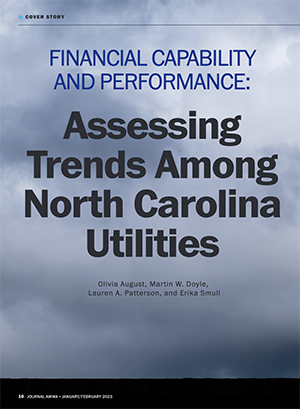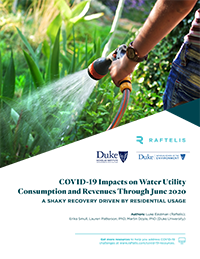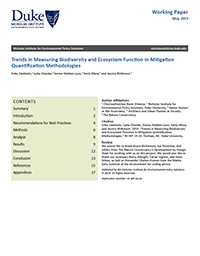Publications
Technology Adoption at Public Agencies: Identifying Challenges and Building Opportunities to Modernize Public Water Data Infrastructure
Modernizing public agency water data depends not only on technology adoption, but also on transformation of how data are managed, shared, and used for decision-making. The Duke Internet of Water (IoW) Technology Adoption Program (TAP) addresses both. This report details efforts by IoW to identify challenges faced by public agencies and recommends a technology adoption roadmap based on nationwide surveys and interviews, best practices identified by public interest technologists, and the principles of modern data infrastructure, along with a case study on the New Mexico Water Data Initiative.
Financial Capability and Performance: Assessing Trends Among North Carolina Utilities
A team of researchers from Duke University's Pratt School of Engineering; Nicholas Institute for Energy, Environment & Sustainability; and the Nicholas School of the Environment assessed the finances of 301 North Carolina water utilities and identified a significant and growing group of communities facing a conflicting dilemma of water affordability and utility cost recovery.
Transformers For Recognition In Overhead Imagery: A Reality Check
There is evidence that transformers offer state-of-the-art recognition performance on tasks involving overhead imagery (e.g., satellite imagery). However, it is difficult to make unbiased empirical comparisons between competing deep learning models, making it unclear whether, and to what extent, transformer-based models are beneficial. In this paper we systematically compare the impact of adding transformer structures into state-of-the-art segmentation models for overhead imagery.
Measuring Water Affordability and the Financial Capability of Utilities
The cost of providing water services is increasing, placing greater financial burdens on individual households and utilities. Five metrics were calculated at multiple volumes of water usage and were applied to 1791 utilities, estimating bills from 2020 rates data, to gauge financial burdens in four states. More than a fifth of the population in 77% of utilities was experiencing poverty, suggesting widespread poverty is a major contributor to utility financial capability challenges.
2020 Aspen-Nicholas Water Forum Water Affordability and Equity Briefing Document
This paper explores the evolution of water services in the United States. Most people have access to water, most tap water is drinkable, most dams are secure, most farms can grow more with less water, and most rivers are cleaner than they were 50 years ago. Most does not mean all. There is growing evidence that an increasing number of Americans are losing access to safe drinking water and sanitation—and others never had it at all.
COVID-19 Impacts on Water Utility Consumption and Revenues Through June 2020
May and June 2020 data for the eight water utilities in our study show diverging trends of water consumption and revenues as the COVID-19 pandemic continues, with states and local governments taking different approaches and timelines to rolling back restrictions. There are signs of recovery in water consumption and revenues for many utilities, mostly due to high residential consumption and billed revenues, not increased usage from non-residential customers.
Harnessing Data Analytics to Accelerate Energy Access: Reflections from a Duke-RTI Convening on Data for Development
One of the defining features of our current era is the proliferation of innovative technologies that constantly generate data and information. Earth observation satellites, ground-based tools such as vehicle-mounted cameras, smart meters, and crowd-sourced platforms all collect and gather data with applications for the energy sector.
Federal Decentralization and Adaptive Management of Water Resources: Reservoir Reallocation by the U.S. Army Corps of Engineers
Reservoir operations must respond to changing conditions, such as climate, water demand, regulations, and sedimentation. The U.S. Army Corps of Engineers (Corps) can reallocate reservoir storage to respond to such changes. We assembled and analyzed a database of reservoir reallocations implemented and proposed by the Corps.
Trends in Measuring Biodiversity and Ecosystem Function in Mitigation Quantification Methodologies
Over the last decade, efforts to use compensatory mitigation to manage and ameliorate the impacts of development on biodiversity and ecosystems around the world have accelerated. Mitigation mechanisms provide a structured way to advance economic development and infrastructure while also achieving environmental goals. In order to operationalize mitigation programs, practitioners need a methodology for calculating or quantifying impacts and offsets (debits and credits). The methods currently employed in the U.S. and abroad are extremely varied. Surprisingly, the literature on best practices or standards for developing science-based approaches to the quantification of impacts and offsets is sparse and there is also no single broadly accepted best practice guidance.
Managing Rivers Under Changing Environmental and Societal Boundary Conditions, Part 1: National Trends and U.S. Army Corps of Engineers Reservoirs
Most major rivers in the United States are managed by a system of reservoirs; many of which were built more than a half century ago. These reservoirs were designed based on environmental, societal, and regulatory assumptions at the time of construction. Since then, we have learned that climate is not stationary, population growth is being decoupled from energy needs and water demand, and new regulations (such as the Clean Water Act and Endangered Species Act) affect how river systems are managed.










